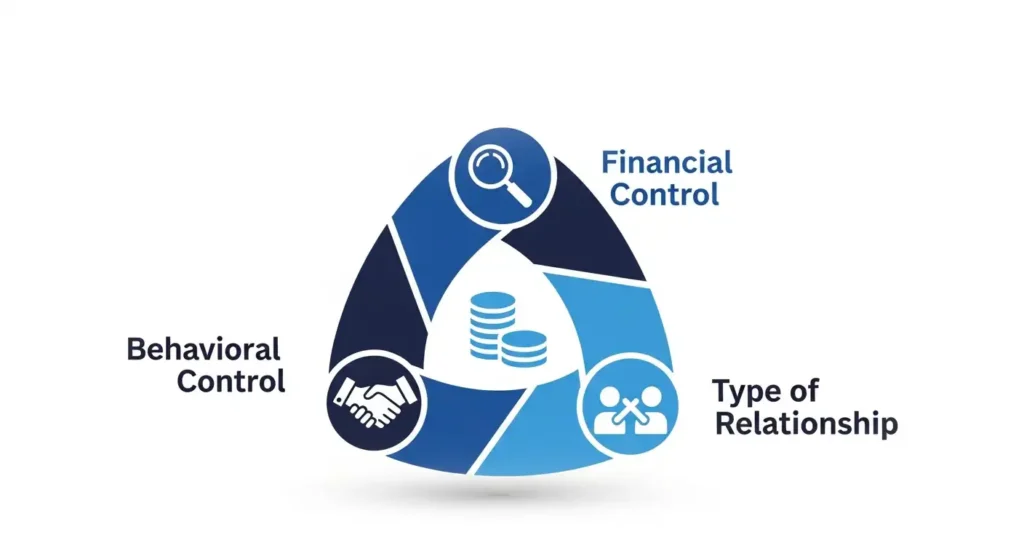
Employee or Independent Contractor? A Quick Guide to the IRS Three-Category Test
For any US business, correctly determining worker classification as either an employee or an independent contractor is a critical compliance issue. This decision profoundly impacts tax obligations, legal liabilities, and operational control. Misclassification can lead to severe penalties from the IRS and other agencies. This comprehensive guide breaks down the IRS Three-Category Test to help your business navigate the complexities of hiring an employee vs. a contractor, ensuring you make the right choice for federal tax purposes.
Introduction: The Critical Importance of Worker Classification
The distinction between an employee and an independent contractor is a foundational legal and financial determination. It dictates tax responsibilities, benefit eligibility, and operational control. The consequences are profound: employees require tax withholding (income, Social Security, Medicare), unemployment tax payments, and adherence to labor laws like minimum wage and overtime. Independent contractors, considered self-employed, handle their own taxes and are not subject to most labor laws, representing a significant cost saving for businesses.
However, due to the potential for abuse, the IRS and the Department of Labor (DOL) have made worker misclassification a priority. An incorrect classification can expose a business to staggering liabilities, including back taxes, steep penalties, and interest.
The Foundation: Common Law and the "Right to Control" Doctrine
At the heart of the IRS framework is the common law "right to control" doctrine. The central question is not whether the business exercises control, but whether it has the right to direct and control how the worker performs their services. This nuanced principle is the cornerstone of the entire analysis. The IRS has streamlined a historical 20-factor test into the current three-category framework to evaluate this right to control.
TL;DR
- Why it Matters: Misclassifying an employee as an independent contractor can lead to significant back taxes, penalties, and legal issues.
- The Core Principle: The IRS's primary focus is the "right to control." Does the business have the right to direct and control how the worker does their job?
- The Three Categories: The IRS groups control factors into three areas:
- Behavioral Control: Who decides how, when, and where the work is done?
- Financial Control: Who controls the economic aspects, like investment, expenses, and opportunity for profit or loss?
- Type of Relationship: How do written contracts, benefits, and the permanency of the job define the relationship?
- No Single Factor Decides: The IRS looks at the entire relationship ("totality of the circumstances"). A written contract alone is not enough.
- State Laws May Differ: Many states, like California, use a stricter "ABC Test," making it even harder to classify a worker as a contractor for state purposes.
Article Index
- Deconstructing the Three-Category Test
- At-a-Glance Factor Analysis
- The Art of Application: A Holistic Assessment
- The High Stakes of Misclassification
- Pathways to Compliance and Relief
- The Broader Regulatory Landscape: Beyond the IRS
- Comparative Analysis of Worker Classification Tests
- Strategic Recommendations for Compliance
Deconstructing the Three-Category Test
The IRS common law rules for determining worker status are organized into three key categories. A business must weigh the evidence within each category to form a complete picture of the working relationship. No single factor is decisive; the overall impression governs the outcome.
1. Behavioral Control
This category examines whether the business has the right to direct and control how the worker performs their job. The more control a business has over the methods and means of work, the more likely the worker is an employee.
Instructions
Does the business instruct the worker on when, where, and how to work? Providing detailed instructions on tools to use, sequence of tasks, or work hours points toward an employee relationship.
Training
Employees are often trained to perform a job in a specific way. Independent contractors typically use their own methods and do not receive training from the client.
Evaluation Systems
If the evaluation system measures the details of how the work is performed, it suggests an employee. Evaluating only the end result is more indicative of a contractor.
2. Financial Control
This category looks at the business aspects of the job and whether the payer has the right to control the economic side of the relationship. Independent contractors generally have more financial autonomy and risk.
Significant Investment
Independent contractors often invest significantly in their own equipment and facilities. Employees rely on the employer to provide tools.
Profit or Loss
An independent contractor can make a profit or suffer a loss based on their business decisions. Employees are typically paid for their time and don't bear this risk.
Method of Payment
Employees are usually paid a regular wage (hourly, weekly). Independent contractors are more often paid a flat fee for a specific project.
3. Type of Relationship
This category explores how the worker and the business perceive their relationship, as evidenced by written agreements, benefits, and the permanency of the work. It provides clues about the parties' intent.
Written Contract?
A contract can state the intended relationship, but the actual facts of the arrangement carry more weight.
Employee Benefits?
Providing benefits like insurance, paid leave, or a pension is a strong indicator of an employee relationship.
Permanency?
An ongoing, indefinite relationship suggests an employee. A relationship for a single project points to an independent contractor.
Another key factor in this category is how integral the worker's services are to the business. If a law firm hires an attorney, those services are a core part of the business, pointing to an employee. If that same firm hires a plumber, the service is ancillary, suggesting a contractor.
At-a-Glance Factor Analysis
| Factor | Indicates Employee Status | Indicates Independent Contractor Status |
|---|---|---|
| Instructions | Business dictates methods, sequence, and hours. | Business specifies only the final deliverable. |
| Training | Business provides training on its procedures. | Worker uses their own pre-existing skills. |
| Investment | Business provides most tools and equipment. | Worker has a significant investment in their own tools. |
| Profit/Loss | Worker is paid a wage and is insulated from loss. | Worker can realize a profit or loss from their work. |
| Payment Method | Regular, recurring payments (hourly, weekly). | Paid a flat fee per project. |
| Benefits | Receives benefits like insurance, paid leave, 401(k). | No employee-type benefits are provided. |
| Permanency | Relationship is ongoing and indefinite. | Relationship is for a specific, finite project. |
The Art of Application: A Holistic Assessment
Properly applying these tests is more art than science. The IRS emphasizes a "totality of the circumstances" approach, meaning no single factor determines the worker's status. Businesses must weigh all relevant evidence to understand the complete picture of the relationship. Meticulous documentation of your analysis is your best defense in an audit, showing you performed due diligence and had a good-faith basis for your decision.
Common Misconceptions
- Remote Work: A worker's location does not determine their status. A business can exert significant behavioral and financial control over a remote worker.
- Part-Time Status: An individual can be a part-time employee. The classification is based on the nature of the relationship, not the number of hours worked.
- Using a 1099 Form: Simply issuing a Form 1099 does not make a worker an independent contractor. The form is a result of the classification, not a determinant of it.
The High Stakes of Misclassification
The financial and legal consequences of misclassifying an employee as an independent contractor can be severe. Businesses face a cascade of liabilities:
- Liability for Unpaid Taxes: The business can be held liable for federal income taxes, both the employer's and employee's share of FICA taxes (Social Security and Medicare), and federal unemployment (FUTA) taxes.
- IRS Penalties and Interest: The IRS imposes significant penalties, which are far more severe if the misclassification is deemed intentional or fraudulent. Interest accrues on all unpaid taxes from their original due date.
- Other Liabilities: A business could be sued for back pay for unpaid overtime under the Fair Labor Standards Act (FLSA) and for the value of denied employee benefits. The reclassification of one worker often triggers audits of all similarly situated workers.
Pathways to Compliance and Relief
For businesses that realize they may have misclassification issues, the IRS offers programs to facilitate compliance and mitigate financial penalties.
- Voluntary Classification Settlement Program (VCSP): This program allows businesses to voluntarily reclassify workers as employees for future tax periods in exchange for a significantly reduced payment on past tax liabilities, without interest or penalties. Strict eligibility requirements apply.
- Section 530 Relief: This "safe harbor" can relieve a business from employment tax liability if it can demonstrate a "reasonable basis" for the misclassification, such as following a long-standing industry practice or a previous IRS audit result.
The Broader Regulatory Landscape: Beyond the IRS
The IRS test is not the only standard. The U.S. Department of Labor uses an "economic realities" test for federal labor laws, and many states have adopted a much stricter standard known as the "ABC test." This creates a complex compliance landscape where a worker might be a contractor for federal tax purposes but an employee under state law.
The State-Level "ABC Test": A Stricter Standard
States like California, New Jersey, and Massachusetts use the ABC test, which presumes a worker is an employee unless the business can prove all three of the following conditions:
- The worker is free from the control and direction of the hiring entity.
- The worker performs work that is outside the usual course of the hiring entity's business.
- The worker is customarily engaged in an independently established trade, occupation, or business.
Prong (B) is often the most difficult for businesses to meet, making it significantly harder to classify workers as independent contractors in these states.
Comparative Analysis of Worker Classification Tests
| Criterion | IRS Common Law Test | DOL Economic Realities Test | State ABC Test |
|---|---|---|---|
| Core Focus | Business's right to control the worker. | Worker's economic dependence on the business. | Whether the worker operates an independent business. |
| Legal Presumption | None. Based on a weighing of facts. | None. Based on a weighing of facts. | Worker is presumed to be an employee. |
| Structure | Flexible, facts-and-circumstances balancing test. | Flexible, facts-and-circumstances balancing test. | Rigid, three-pronged test. Business must prove all three. |
Strategic Recommendations for Compliance
To navigate this complex landscape, businesses must be proactive. We recommend you:
- Conduct Regular Audits: Review all independent contractor relationships annually to ensure they haven't evolved into employment relationships.
- Use a Checklist: Develop and use a comprehensive checklist based on the IRS three-category test (and the ABC test, if applicable in your state).
- Document Everything: Maintain a file for each contractor with your classification analysis and a signed agreement.
- Draft Clear Contracts: Use a well-drafted independent contractor agreement that accurately reflects the reality of the relationship.
- Consult Experts: When in doubt, seek guidance from experienced tax and employment legal counsel.
Still Unsure? We Can Help.
Navigating the IRS Three-Category Test can be challenging. For a hands-on approach, use the TimeTrex interactive calculator to analyze your specific situation and get a clearer picture of your worker's classification status.
Use the Free IRS Test CalculatorDisclaimer: The content provided on this webpage is for informational purposes only and is not intended to be a substitute for professional advice. While we strive to ensure the accuracy and timeliness of the information presented here, the details may change over time or vary in different jurisdictions. Therefore, we do not guarantee the completeness, reliability, or absolute accuracy of this information. The information on this page should not be used as a basis for making legal, financial, or any other key decisions. We strongly advise consulting with a qualified professional or expert in the relevant field for specific advice, guidance, or services. By using this webpage, you acknowledge that the information is offered “as is” and that we are not liable for any errors, omissions, or inaccuracies in the content, nor for any actions taken based on the information provided. We shall not be held liable for any direct, indirect, incidental, consequential, or punitive damages arising out of your access to, use of, or reliance on any content on this page.
About The Author

Roger Wood
With a Baccalaureate of Science and advanced studies in business, Roger has successfully managed businesses across five continents. His extensive global experience and strategic insights contribute significantly to the success of TimeTrex. His expertise and dedication ensure we deliver top-notch solutions to our clients around the world.
Time To Clock-In
Start your 30-day free trial!
Experience the Ultimate Workforce Solution and Revolutionize Your Business Today
- Eliminate Errors
- Simple & Easy To Use
- Real-time Reporting

Saving businesses time and money through better workforce management since 2003.
Copyright © 2025 TimeTrex. All Rights Reserved.
